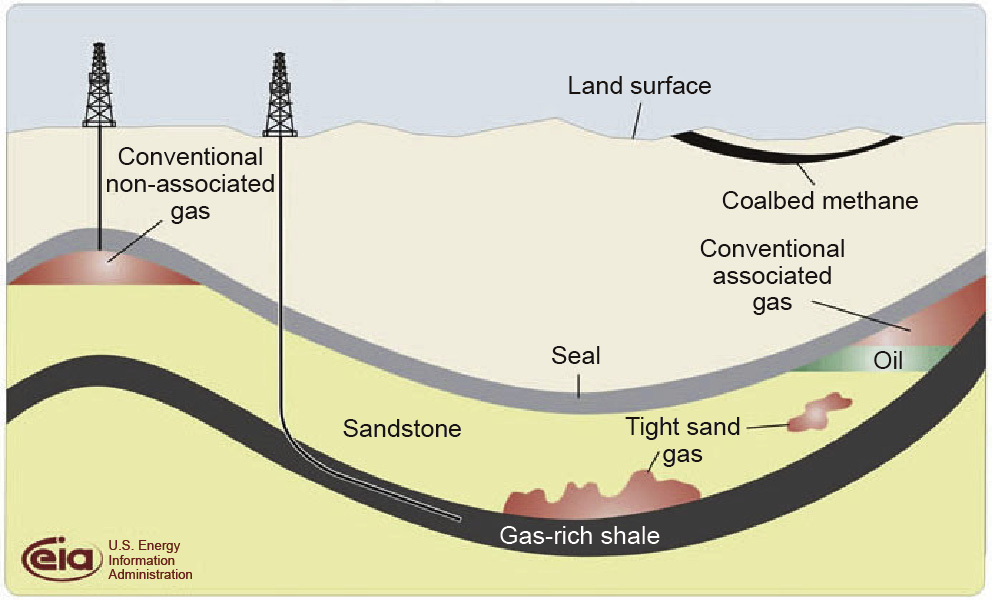The global energy landscape has very often been subject to upheaval due to geopolitical strife. Americans old enough will vividly recall waiting in long lines at gasoline stations during the 1973 oil embargo. At present, there is another sort of upheaval afoot that is totally driven by technology—hydraulic fracturing and horizontal drilling. These are technologies which have been developed over decades, mostly in the United States—but it is only in the last few years that their enormously successful development and widespread utilization would be noticed as"news”[1–3], because of its impact on the world markets for energy and down-stream industrial chemicals. The volumes of petroleum and natural gas hydrocarbons produced in the United States in 2015 were the largest in the world. The United States surpassed total Russian oil and gas production in 2012; in 2011 the United States became the world’s largest producer of natural gas; and in 2013[4] of all petroleum hydrocarbons. Total US crude oil production presently approaches 9.5×106 barrels per day(bpd), just short of the US record level of 1× 107 bpd in 1970. On an annual basis, total production rose from 1.829×109 barrels to 3.402 ×109 barrels in just nine years from 2008 to 2017[5]. The incentive for this development was the high price of oil which reached 100 USD a barrel several years ago and, as of March 2018, was at about 65 USD a barrel, a price which allows for profitable recovery of shale oil. And, after a 40-year ban was lifted in 2015, the United States is now an exporter of oil and liquefied natural gas (LNG)[6]. The shale gas boom has also led to enormous investments in downstream chemicals production in the United States.
If not quite energy independent, the United States is now far less dependent on overseas oil and natural gas. The geopolitical implications of this development are far-reaching—much beyond the scope of this short news piece—but one may see a sample of opinions in Refs.[1–3].
The source of this oil and natural gas is in exploiting oil shale deposits, long known to be in abundance in the United States, but not accessible in an economically practical way. Persistent development of the technologies for hydraulic fracturing and directional/ horizontal drilling, commonly referred to as "fracking”when the technologies are combined, changed that. Fracking involves pumping a water/chemical mixture typically containing sand into a deposit at high pressure fracturing the rock in a formation that has been directionally drilled. When the water is pumped out, the sand props the rock fractures open allowing paths for oil and gas to flow to the well head for extraction. The first hydraulic fracturing occurred in the 1860s, but more significant development began in 1947 and the technique was widely adopted in conventional oil recovery by the 1960s and 1970s[7]. What has been called “modern day fracking”began in the 1990s when the US independent oil and gas developer George P.Mitchell combined hydraulic fracturing with directional/ horizontal drilling[7,8]. Drilling begins vertically and is halted when the well is about 100 m from the target deposit. A hydraulic motor is then installed between the drill string and bit and, with the drill bit at an angle, mud is pumped through it to allow it to turn and drill at an angle from vertical without rotating the entire drill string. When the drill bit enters the deposit it is modified to drill horizontally. Such nominally horizontal drill strings can be controlled with enough precision to follow the profile of a deposit.
Shale deposits in the United States typically extend over large horizontal distances and are of relatively limited thickness, as shown in Fig. 1[9]. They contain oil and gas that it is difficult to extract by conventional means because of the lack of permeability of the shale. That problem was solved by hydraulic fracturing, but that alone is not sufficient, since the deposits are so "thin.”Conventional vertical drilling would only access a small section of what amounts to a huge pancake. Manipulating the drill string to move from vertical to horizontal in the deposit shortens the distance for oil and gas to flow to the well bore and together with extending the bore out for a kilometer or more allows for economic recovery. A single well head can deploy multiple horizontal drill strings to tap all quadrants of a deposit.
《Fig. 1》

Fig.1.Schematic geology of natural gas resources[9].
Shale gas typically contains 70%–95% methane, useful for its energy content, less than 15% ethane and less than 5% propane. Ethane and propane are separated from the methane and,despite its limited content, ethane (C2H6) is the most important component for chemistry. It is steam-cracked to make ethene (C2H4, also known as ethylene), a basic building block for downstream chemicals. The chemical industry produces 1.5×108 t of ethene per year,more than for any other chemical building block [6]. The historical route to ethane in Europe and Asia has been from naphtha refined from oil, because of their limited supply of natural gas liquids and because petroleum is more economical to import than LNG, but is more expensive to produce. In the Middle East, where there is ample natural gas, ethane is derived from natural gas liquids [10]. The United States is competitive with the Middle East, but strongly advantaged over Europe and Asia. As a consequence there has been a massive chemicals building boom in the United States.
In April 2018, the American Chemistry Council reported that 194 billion USD has been invested since 2010 in over 325 projects for new chemicals production in the United States due to the availability of the abundant, stable, and cost-competitive supply of natural gas from shale deposits—shale gas, for short[11]. This investment is an incremental number above and beyond that which would have been necessary investments by the chemical industry for reasonable volume expansions and process upgrades. It has driven a renaissance in the US chemical industry,which has transitioned from the world’s high-cost producer to one of the lowest cost producers. Much of the investment is geared toward exports and 64% of the investment is for projects by foreign firms or projects with a foreign partner. Ethylene capacity in the United States is expected to increase from 2.9×107 t in 2015 to 4×107 t in 2021[12].
The shale oil and gas boom is not without its detractors. There have been concerns that fracking can lead to contamination of ground water supplies,incite local earthquakes, and lead to escape of methane, a more potent greenhouse gas than CO2, during extraction[13,14]. It has also been noted that availability of large quantities of low-cost shale oil and gas may discourage/ delay the conversion to low-carbon energy sources like wind and solar to combat global warming[1,15].
Concerns about fracking have led to its being banned in Germany, France,and the New York State in the United States[13], but have not derailed the shale oil and gas boom in the rest of the United States. Arguably, shale operators have been reluctant to endorse the perceived problems, but persistent government and community pressure has forced them to continually modify their processes in attempts to mitigate potential negative impacts.
The availability of low-cost shale gas has largely been responsible for the decline of the coal industry in the United States. Proponents point out that natural gas reduces greenhouse gas emissions compared to coal, that it is far easier for a natural gas-fired electricity plant to cycle on and off as necessary and that, absent substantial improvements in electricity storage technology, natural gas plants will always be needed to guard against loss of supply from solar or wind facilities. It has also been noted that the costs of solar and wind facilities have continued their steady decline [16] and local government regulations, especially in the western US states, continue to encourage introduction of solar and wind farms to replace traditional coal and nuclear power and to favor such facilities over gas plants in some cases[15].













 京公网安备 11010502051620号
京公网安备 11010502051620号




